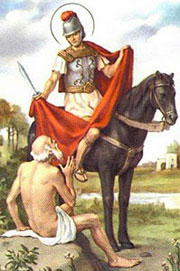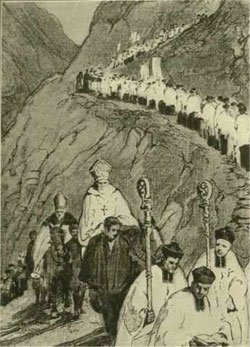| |

Traditions, folklore, history and more. If it's Irish, it's here. Or will be!
"People will not look forward to posterity who never look backward to their ancestors."
-Edmund Burke




Quotes
Library: Books, Movies, Music
Prints & Photos
Poetry
Jokes


Shops Ireland
Bunús na Gaeilge
(Basic Irish)
Circle of Prayer
Blessings
Did You Know?
Himself/Herself
Write to Us
Readers Write..
Links/Link to Us
Advertise with us
Awards & Testimonials
Submissions Guide


|
|
|
Irish Celebrations - The Feast of St. Martin
by Bridget Haggerty
 A legend from Co. Wexford says that the fishing boats were out on the morning of one November 11th, when an apparition of St Martin was seen walking on the waves. He admonished them to put their oars into the water and return to their harbors. All those who ignored his warning perished in a storm that came up in the afternoon. Since then, no Wexford boat would put out to sea on St. Martin’s Day. A legend from Co. Wexford says that the fishing boats were out on the morning of one November 11th, when an apparition of St Martin was seen walking on the waves. He admonished them to put their oars into the water and return to their harbors. All those who ignored his warning perished in a storm that came up in the afternoon. Since then, no Wexford boat would put out to sea on St. Martin’s Day.
It was also the custom in Wexford on November 11th, that if a sheep or goat was ill and seemed likely to die, the farmer would put a slit in one ear and devote the animal to the saint. If it recovered, it would be killed and eaten on a future St. Martin’s Day. It would not be sold in the interim - not even for ten times its value.
In the brief history that follows, you’ll discover that St. Martin is the patron saint of France. So, how did he come to be so loved by the Irish? In my research, I was surprised to learn that St. Martin is the uncle of St. Patrick and that he was the one who gave Ireland’s patron saint his monastic habit and his tonsure.
According to one resource, Patrick entered the monastery at Marmoutier, where he remained until his uncle died in 397. Apparently, it’s also from St. Patrick that we get the story of the Martinmas pig. To honor his uncle, he killed a pig on the eve of his feast day and offered it to the monks at Marmoutier, should they be inclined to come for it. From that point on, it became the custom to sacrifice an animal on Martinmas and the pig was preferred over all others.
St. Martin of Tours - a brief history
Martin was born in Hungary in 316. He was the son of a pagan army officer who moved with his family to his father's new post in Pavia, Italy. At the age of 10, and against his parents’ will, he became a catechumen and took lessons at the local church. Several years later, his love of God was so intense that he wanted to become a hermit. However, as the son of an army veteran, he was compelled to go into the service when he was 15 years old.
His military career took him to a post in Amiens, France. There, during the bitterly cold winter of 337, he was approached by an almost-naked beggar. Martin immediately sliced his cloak in two and wrapped half of it around the shivering vagrant. According to his biographer, Christopher Donaldson, that same night Martin had a dream. He saw Jesus wrapped in the piece of cloak he had given away and Jesus said to him, "Martin, yet a catechumen, has covered me with this garment." Following this dream, he immediately sought to be baptized.
When he was about 20, barbarians invaded Gaul. Martin and his companions were presented to Emperor Julian in order to receive a commission to fight the invaders. Martin refused and told Julian that he had served him as a soldier but now he was a soldier of Christ and it was unlawful for him to fight. The emperor accused him of cowardice. Martin countered by saying that he was willing to go into battle unarmed and stand between the opposing parties in the name of Jesus.
Miraculously, he was saved from being placed into such a dangerous position because that night, the barbarians demanded and received an armistice. Three years later, in 339, Martin requested and was given his discharge. Now, he could freely pursue his burning desire to serve God.
For a time, Martin lived in Italy and Dalmatia; he then went to Poitiers where Bishop Saint Hilary took him as a disciple. It was during this period that he had another dream - this one calling him back home to Hungary. There, he converted his mother and many others. From Hungary, Martin’s travels took him back to Italy where he found that Saint Hilary had been exiled by Auxtensius, the Arian bishop. It was then that he entered the monastic life at a place near Milan. However, Auxtensius seized the See of Milan and drove Martin from the diocese. He ended up on an island in the Gulf of Genoa, where he lived as a recluse until 360, when the banished Hilary was allowed to come out of exile.
Martin left the island and travelled to Rome to meet Saint Hilary en route and accompany him back to his See in Poitiers. Hilary knew that Martin preferred to live the monastic life, so he gave him some land on which Martin founded the first monastic community in Gaul. He lived there for 10 years, preaching and reputedly performing many miracles. Then, around 371, Tours chose him as its third bishop.
He lived in a cell by the church but soon retreated from the city and its distractions to Marmoutier, where he founded yet another great monastic center. Before long, the community had grown to more than 80 monks. They engaged in no art or business transactions; the older ones spent all of their waking hours in prayer and the younger ones in writing. It was out of this monastery that many bishops were chosen, because every city wanted a religious leader who had been bred under the discipline of St. Martin.
In Marmoutier, Martin lived privately as a monk; publicly, he ardently discharged his episcopal duties. Every year, he visited each of his parishes in rural regions, travelling by foot, by donkey, or by boat. Previous to these innovative efforts to spread the faith, Christians were primarily to be found only in urban areas.
 Undoubtedly, St. Martin was one of the greatest pioneers of Western monasticism, directly influencing the type of monasteries established in Ireland, Scotland and Wales. He was also one of the most popular saints in the middle ages. After his death in 397, his successor, Saint Brice, built a chapel over his grave. This was later replaced with a basilica. Today, he is the patron saint of France and his shrine attracts thousands of pilgrims. He is also the patron saint of many diverse groups, including wool-weavers - because he divided his cloak. Undoubtedly, St. Martin was one of the greatest pioneers of Western monasticism, directly influencing the type of monasteries established in Ireland, Scotland and Wales. He was also one of the most popular saints in the middle ages. After his death in 397, his successor, Saint Brice, built a chapel over his grave. This was later replaced with a basilica. Today, he is the patron saint of France and his shrine attracts thousands of pilgrims. He is also the patron saint of many diverse groups, including wool-weavers - because he divided his cloak.
Sources: Martin of Tours: The Shaping of Celtic Christianity by Christopher Donaldson; The Story of The Irish Race by Suemas MacManus, and The Year in Ireland by Kevin Danaher.
Images: Saint Martin from Catholic Forum
Pilgrimage to St. Martin by Blanche McManus
Image reproduced with the kind permission of Jeff Kelley of Kellscraft Studios. To view more of Ms. McManus work - and a wide variety of other wonderful images, (including Jeff's handsome collection of cats), click KellsCraft.
|
|
Fri, Sep 27, 2024
 The Galway Hooker The Galway Hooker
This unique vessel, with its distinctive curved lines and bright red sails, originated in the village of Claddagh. During the 19th century, hookers supported a significant fishing industry and also carried goods, livestock and fuel. Seán Rainey is remembered for building the last of the original boats, the Truelight, for Martin Oliver who was to become the last king of the Claddagh; as king, he was entitled to white sails on his boat. Since the mid seventies, many of the old sailing craft which were on the verge of extinction have been lovingly restored and new ones have been built. During the summer months they can be seen at festivals such a Cruinniú na mBád - the Gathering of the Boats - in Kinvara.
Click for More Culture Corner.
Illustrated with designs from the Book of Kells and other Celtic and Irish designs, the prayers reflect a profound view of nature and life. I strongly recommend this to pastors or lay people with any interest in Celtic culture. Edited from an Amazon review
Click here for Celtic Prayers.
|
A fascinating, very cleverly written account that's part fiction and part fact. But don't be misled by the "fiction" part. The stories that Mr. Moorhouse tells are all based on thoroughly researched historical evidence. Bridget Haggerty
"Moorhouse writes with eloquence and a quiet humor calculated to charm even the blackest of heathens." Atlantic Monthly
"The chilling facts of the monks' penitent lives are real enough to send a shiver down an Irish Catholic's spine." New York Times Book Review
Click here for Sun Dancing.
|
|
|
|
|




 The Galway Hooker
The Galway Hooker